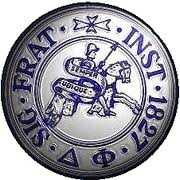| Kappa Alpha Society | |
|---|---|
| ΚΑ | |
 |
|
| Founded | November 26, 1825 Union College |
| Type | Literary Society and Social Fraternity |
| Colors | Scarlet |
| Symbol | Kappa Alpha Key |
| Flower | Carnation |
| Chapters | 15 (9 active) |
| Headquarters | PO Box 876 Ithaca, New York, US |
| Homepage | http://www.ka.org |
The Kappa Alpha Society (ΚΑ), founded in 1825, was the progenitor of the modern fraternity system in North America. It was the first of the fraternities which would eventually become known as the Union Triad. In addition, Baird’s Manual states that ΚΑ, unlike other fraternities with claims to the contrary, has maintained a continuous existence since its foundation, making it the oldest undergraduate fraternity that exists today.[1] As of 2012, there are nine active chapters in the United States and Canada.
History[edit]
According to Baird’s Manual, nine undergraduates at Union College inSchenectady, New York—John Hart Hunter, John McGeoch, Isaac W. Jackson, Thomas Hun, Orlando Meads, James Proudfit, and Joseph Anthony Constant of the class of 1826, and Arthur Burtis and Joseph Law of the Class of 1827—established the Society on November 26, 1825 from an informal group calling itself The Philosophers, which was established by Hunter, Jackson, and Hun in 1823. The organization represents the middle link between secret societies, literary societies, and Greek-letter organizations like Phi Beta Kappa. In the words of founding member Arthur Burtis:
| “ | After we were domiciled in our upper chamber, in the fourth story of the south section—South College—northeast corner… we now and then beguiled the long winter evenings and entertained our friends with a few baked potatoes and salt and comforted them with apples. Jackson, Hun, Meads, Constant, and McGeoch were often the genial sharers of our simple meal, which was enlivened with mirth and wit and merry song…. It was determined to raise Hunter to an elevated seat on the woodpile, which stood in the corner of the room. When he was exalted to his high eminence, with his pipe in his mouth, he became the leader of this little band. Whereupon I suggested it would be right for us to get our light from this central luminary and that I would carry it to the others…. This band was now beginning to assume shape and form and comely order. | ” |
The first expansion of the Society took place in 1833 at Williams College at the request of fourteen students led by Azariah S. Clark of the class of 1834.
The Kappa Alpha Society, emulated by Sigma Phi (est. 1827) and Delta Phi (est. 1827), constitute the Union Triad, the pioneers of the North American system of social fraternities.[2]
This organization is not to be confused with the Kappa Alpha Order, a completely separate national fraternity.
Chapters[edit]
Chapters are designated with an abbreviation of the institution’s Latin name.
| No. | Dates | Chapter | Institution | Location | Status |
|---|---|---|---|---|---|
| 1. | Nov. 26, 1825–2003, 2011–present | New York Alpha (CC) | Union College | Schenectady, New York | Active |
| 2. | Oct. 29, 1833–1983 | Massachusetts Alpha (CG) | Williams College | Williamstown,Massachusetts | Dormant |
| 3. | Nov. 26, 1844–1854, 1879–2003, 2005–present | New York Beta (CH) | Hobart College | Geneva, New York | Active |
| 4. | Oct. 21, 1852–1855, 1983–1998 | New Jersey Alpha (CNC) | Princeton University | Princeton, New Jersey | Dormant |
| 5. | Jan. 8, 1857–1861 | Virginia Alpha (VV) | University of Virginia | Charlottesville,Virginia | Dormant |
| 6. | Nov. 12, 1868–1990, 2007–present | New York Gamma (VC) | Cornell University | Ithaca, New York | Active |
| 7. | Feb. 19, 1892–present | Ontario Alpha (VT) | University of Toronto | Toronto, Ontario | Active |
| 8. | Jan. 2, 1894–present | Pennsylvania Alpha (VL) | Lehigh University | Bethlehem,Pennsylvania | Active |
| 9. | Apr. 21, 1899–1971, 1987–2006, 2012–present | Quebec Alpha (VM) | McGill University | Montreal, Quebec | Active |
| 10. | Apr. 26, 1913 – present | Pennsylvania Beta (VP) | University of Pennsylvania | Philadelphia,Pennsylvania | Active |
| 11. | Feb. 14, 1948–present | Ontario Beta (VOO) | University of Western Ontario | London, Ontario | Active |
| 12. | Mar. 18, 1967–1993, 1994–1997 | Connecticut Alpha (VW) | Wesleyan University | Middletown,Connecticut | Dormant |
| 13. | Nov. 5, 1988–2011 | Alberta Alpha (VA) | University of Alberta | Edmonton, Alberta | Dormant |
| 14. | Nov. 23, 1991–1999 | Alberta Beta (VAC) | University of Calgary | Calgary, Alberta | Dormant |
| 15. | Nov. 21, 2009–present | Nova Scotia Alpha (VD) | Dalhousie University | Halifax, Nova Scotia | Active |
Coeducation[edit]
The Union and Wesleyan chapters were co-educational (male and female members) in the recent past. The chapter at Wesleyan University, which existed from 1967 to about 1997, was at various times co-educational both as part of The Society and as a local starting in 1974. The Union Chapter was co-ed from 1991 until 2003. There are currently no co-educational chapters.
Contributing members[edit]
- John Hart Hunter, Union College, 1824. Founder.
- Fitz Hugh Ludlow, Union College, 1856. Song writer, author and editor.
Notable members[edit]
Over the course of its nearly 200-year history, The Kappa Alpha Society has produced a substantial number of notable members in widely varied fields.


